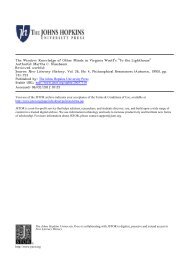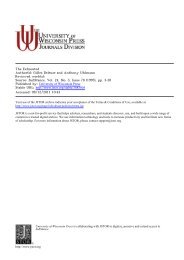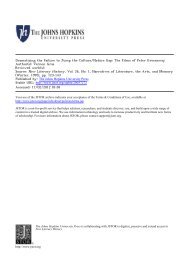Krauss-LeWitt in Progress - engl328
Krauss-LeWitt in Progress - engl328
Krauss-LeWitt in Progress - engl328
You also want an ePaper? Increase the reach of your titles
YUMPU automatically turns print PDFs into web optimized ePapers that Google loves.
50<br />
OCTOBER<br />
the triumphant progress of rationality. It is <strong>in</strong>structive, therefore, to th<strong>in</strong>k about<br />
the claims that are made for <strong>LeWitt</strong> <strong>in</strong> the context of a broader argument about the<br />
nature of abstraction. Suzi Galik's <strong>Progress</strong> <strong>in</strong> Art, for example, views the entire<br />
range of the world's visual culture as a problem <strong>in</strong> cognitive development. And<br />
abstract art, set with<strong>in</strong> this problematic, appears as the necessary fruits of some<br />
k<strong>in</strong>d of world <strong>in</strong>tellectual growth.<br />
Put very briefly, her argument is that the history of art divides <strong>in</strong>to three<br />
dist<strong>in</strong>ct periods, the first consist<strong>in</strong>g of all visual representation prior to the<br />
discovery of systematic perspective, the second, beg<strong>in</strong>n<strong>in</strong>g with the Renaissance,<br />
def<strong>in</strong>ed by the mastery of perspective, and the third, that of modernism, heralded<br />
by the onset of abstraction. As one might gather from the title of her book, the<br />
arthor's contention is that these divisions mark off stages <strong>in</strong> a radical progression,<br />
each stage outmod<strong>in</strong>g and supersed<strong>in</strong>g the one that came before it. The model for<br />
this idea of "progress <strong>in</strong> art" is that of human cognitive development, beg<strong>in</strong>n<strong>in</strong>g<br />
with the most childlike modes of thought and mov<strong>in</strong>g forward towards the greater<br />
complexity of operational, formal reason<strong>in</strong>g. Project<strong>in</strong>g this developmental<br />
model of the <strong>in</strong>dividual, taken from the work of Piaget, onto the entire corpus of<br />
world art, Gablik speaks of the history of styles as a matter of "advance"-a<br />
process of "evolution" towards stages of <strong>in</strong>creas<strong>in</strong>gly higher <strong>in</strong>tellectual organiza-<br />
tion. "The history of art exemplifies fundamental patterned pr<strong>in</strong>ciples of mental<br />
growth," she writes.5 Thus the Renaissance superseded all previous forms of<br />
representation because of the axiomatic, deductive nature of perspective, so that<br />
the space of the phenomenal world could be understood as unified by a system of<br />
coord<strong>in</strong>ates <strong>in</strong>dependent of "raw" perception. But the modern period (beg<strong>in</strong>n<strong>in</strong>g<br />
with Cubism) cognitively outdistances the Renaissance by withdraw<strong>in</strong>g this<br />
power of coord<strong>in</strong>ation from the real world entirely. In so do<strong>in</strong>g it demonstrates the<br />
<strong>in</strong>dependence of all deductive or logical systems from the process of observation.<br />
In Gablik's view the achievement of abstract art is its freedom from the demands of<br />
perceptual reality and its amibition to demonstrate what Piaget has termed the<br />
"formal-operational stage" of human th<strong>in</strong>k<strong>in</strong>g.<br />
This raised a problem which I first solved <strong>in</strong> the follow<strong>in</strong>g way. I had<br />
say sixteen stones, four <strong>in</strong> each of my four pockets these be<strong>in</strong>g the two<br />
pockets of my trousers and the two pockets of my greatcoat. Tak<strong>in</strong>g a<br />
stone from the right pocket of my greatcoat, and putt<strong>in</strong>g it <strong>in</strong> my<br />
mouth, I replaced it <strong>in</strong> the right pocket of my greatcoat by a stone from<br />
the right pocket of my trousers, which I replaced by a stone from the left<br />
pocket of my trousers, which I replaced by a stone from the left pocket<br />
of my greatcoat, which I replaced by the stone which was <strong>in</strong> my mouth,<br />
as soon as I had f<strong>in</strong>ished suck<strong>in</strong>g it.<br />
It is not surpris<strong>in</strong>g that <strong>LeWitt</strong>'s defenders would f<strong>in</strong>d much to admire <strong>in</strong> the<br />
thesis of <strong>Progress</strong> <strong>in</strong> Art. For an argument that draws a direct parallel between<br />
5. Suzi Gablik, <strong>Progress</strong> <strong>in</strong> Art, New York, Rizzoli, p. 147.











